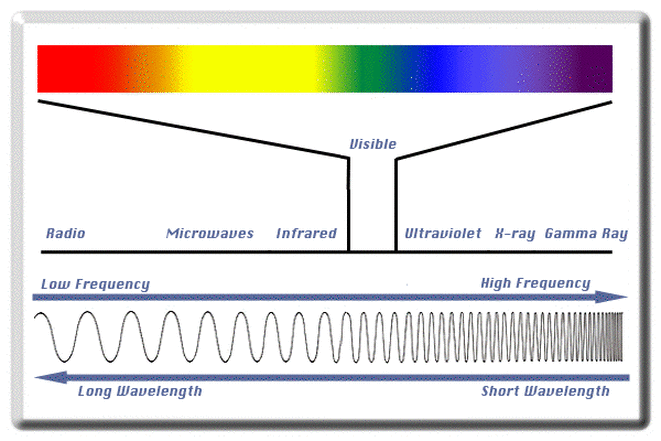Goal 4 - The Electromagnetic Spectrum
Activity #1:
Go to the website below.
http://spaceplace.nasa.gov/ir-photo-album/redirected/
1)Click “play”
2) Click the “start” button on the upper right hand corner
3) IN YOUR NOTEBOOK……Move the infrared camera over the item and list thehottest and coldest parts of the item/picture. Do this for all 14 items.
(you can change the item in the window ). Ex. Boys head, hot and cold cups, camel, etc…
Activity #2
Go to the website below.
http://www.teachersdomain.org/resource/phy03.sci.phys.mfw.spectrum/
1) Click the green “view” button.
2) Click the green “A Self-Guided Tour of the electromagnetic Spectrum” button to the right of the screen.
3) Click “begin the tour”
4) Beginning at Radio Waves, record all the examples shown of each electromagnetic wave.
Move the cursor over each item and explain how it works OR one interesting fact.
Use Complete sentences. When each section is complete, click the next button to advance to the next wave.
Stop after Gamma Rays.
1st example: Radio Waves- Television- television stations use radio waves to broadcast signals through the air.
OR If you tune your TV just below 88 megahertz, you would pick up and hear the audio transmission of channel 6.
Two-Way
Radio-…………………………………………………………etc.etc.etc.
Activity #3
Go to the website below:
http://earthguide.ucsd.edu/eoc/special_topics/teach/sp_climate_change/p_emspectrum_interactive.html
1) Slowly drag and release the green arrow in the diagram under Wavelength, Frequency and Energy to study interesting facts
about individual EM waves.
2) In your notebook chose 4 of the 7 types of EM waves ( Radio, Microwave, Infrared, Visible Light, Ultra-violet, X-ray or Gamma)
A. Name of Radiation
B. 2 facts shown from above the chart
C. Draw the Frequency of the wave
D. Identify the level of energy
Activity #4 (If not working skip it)
Go to the website below:
http://www.teachersdomain.org/resource/phy03.sci.ess.eiu.chandra/
1) Click on View.
2) Select 3 of the 5 astronomical objects to observe.
3) For your information: Telescopes are engineered to detect a specific range of wavelengths of electromagnetic radiation.
Images from a variety of these telescopes show different aspects of the same astronomical objects.
Radio images highlight the presence of cooler gas clouds (especially hydrogen),
infrared images show areas of low-energy heat, visible light images depict
primarily gases and dust, and x-ray images reveal high-energy heat
emissions.
4) In your notebook….Write down how the images for each object found in Space are
different based on which type of EM wave is used.
Activity #5
Go to the website below:
http://www.sciencelearn.org.nz/Science-Stories/Harnessing-the-Sun/Sci-Media/Animations-and-Interactives/The-electromagnetic-spectrum
1) Click on the image to open it up.
2) Drag the circle slider to each type of EM Wave.
3) In your notebook…List each type and 1 FACT from each description that YOU think is most important.
- Type of Electromagnetic Wave
IMPORTANT Fact
Radio
Microwave
Infrared
Visible Light
UltraViolet
X-Ray
Gamma
Go to the website below.
http://spaceplace.nasa.gov/ir-photo-album/redirected/
1)Click “play”
2) Click the “start” button on the upper right hand corner
3) IN YOUR NOTEBOOK……Move the infrared camera over the item and list thehottest and coldest parts of the item/picture. Do this for all 14 items.
(you can change the item in the window ). Ex. Boys head, hot and cold cups, camel, etc…
Activity #2
Go to the website below.
http://www.teachersdomain.org/resource/phy03.sci.phys.mfw.spectrum/
1) Click the green “view” button.
2) Click the green “A Self-Guided Tour of the electromagnetic Spectrum” button to the right of the screen.
3) Click “begin the tour”
4) Beginning at Radio Waves, record all the examples shown of each electromagnetic wave.
Move the cursor over each item and explain how it works OR one interesting fact.
Use Complete sentences. When each section is complete, click the next button to advance to the next wave.
Stop after Gamma Rays.
1st example: Radio Waves- Television- television stations use radio waves to broadcast signals through the air.
OR If you tune your TV just below 88 megahertz, you would pick up and hear the audio transmission of channel 6.
Two-Way
Radio-…………………………………………………………etc.etc.etc.
Activity #3
Go to the website below:
http://earthguide.ucsd.edu/eoc/special_topics/teach/sp_climate_change/p_emspectrum_interactive.html
1) Slowly drag and release the green arrow in the diagram under Wavelength, Frequency and Energy to study interesting facts
about individual EM waves.
2) In your notebook chose 4 of the 7 types of EM waves ( Radio, Microwave, Infrared, Visible Light, Ultra-violet, X-ray or Gamma)
A. Name of Radiation
B. 2 facts shown from above the chart
C. Draw the Frequency of the wave
D. Identify the level of energy
Activity #4 (If not working skip it)
Go to the website below:
http://www.teachersdomain.org/resource/phy03.sci.ess.eiu.chandra/
1) Click on View.
2) Select 3 of the 5 astronomical objects to observe.
3) For your information: Telescopes are engineered to detect a specific range of wavelengths of electromagnetic radiation.
Images from a variety of these telescopes show different aspects of the same astronomical objects.
Radio images highlight the presence of cooler gas clouds (especially hydrogen),
infrared images show areas of low-energy heat, visible light images depict
primarily gases and dust, and x-ray images reveal high-energy heat
emissions.
4) In your notebook….Write down how the images for each object found in Space are
different based on which type of EM wave is used.
Activity #5
Go to the website below:
http://www.sciencelearn.org.nz/Science-Stories/Harnessing-the-Sun/Sci-Media/Animations-and-Interactives/The-electromagnetic-spectrum
1) Click on the image to open it up.
2) Drag the circle slider to each type of EM Wave.
3) In your notebook…List each type and 1 FACT from each description that YOU think is most important.
- Type of Electromagnetic Wave
IMPORTANT Fact
Radio
Microwave
Infrared
Visible Light
UltraViolet
X-Ray
Gamma



